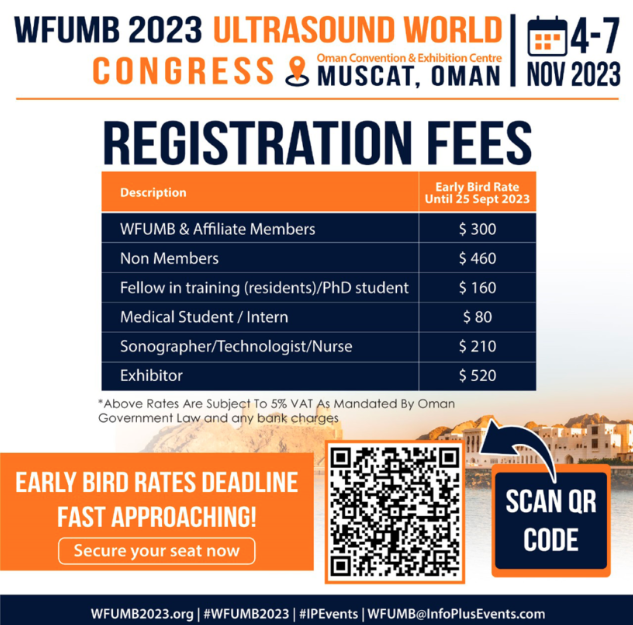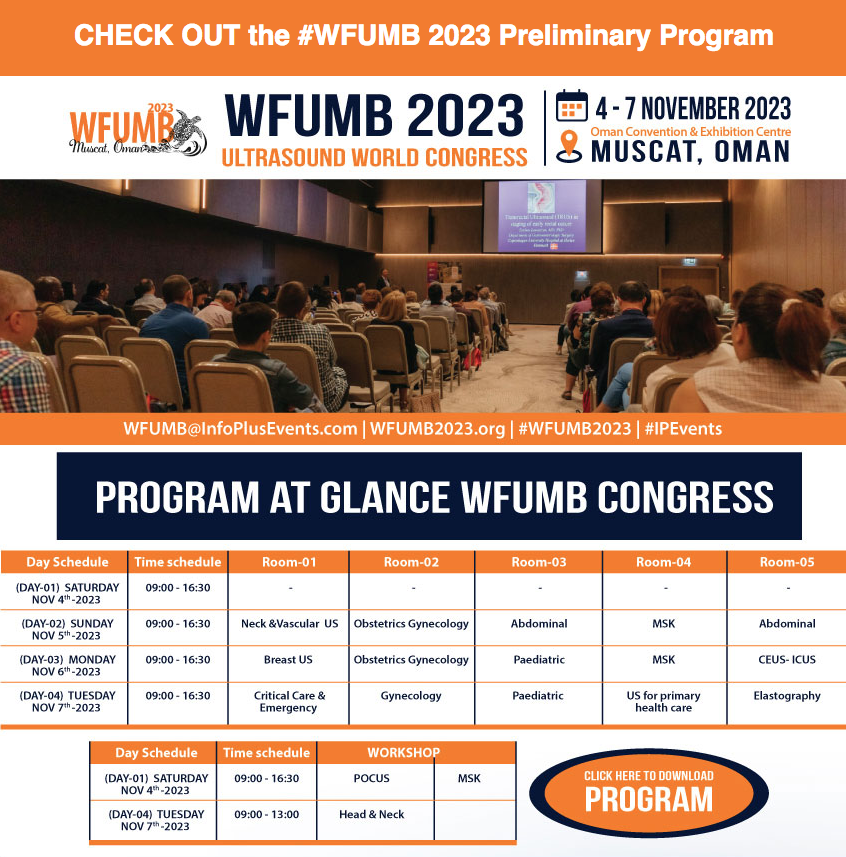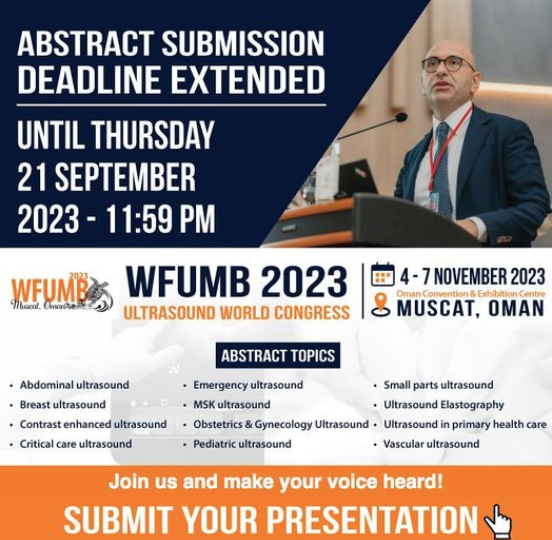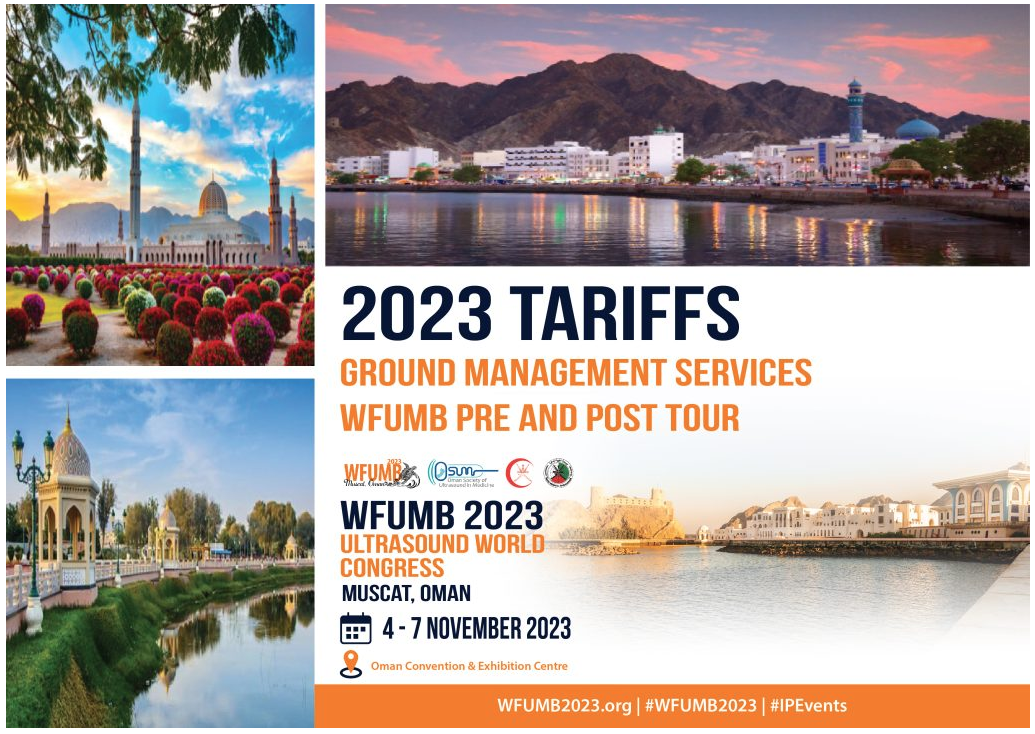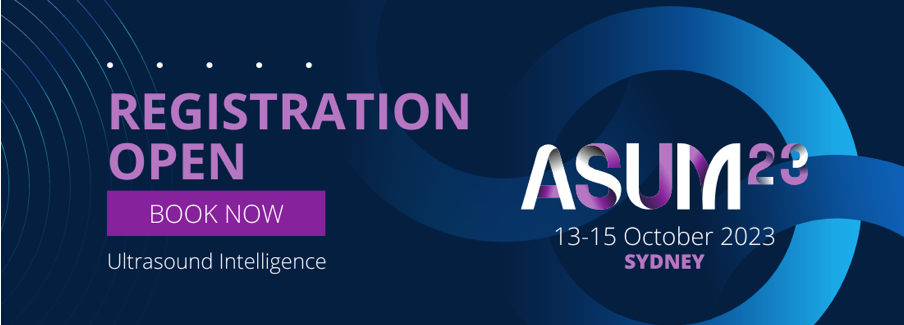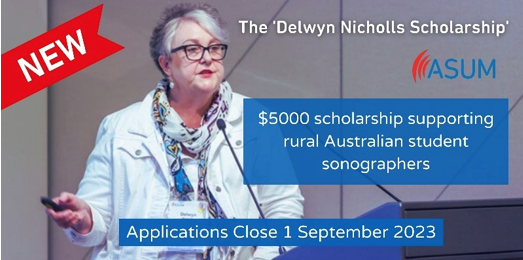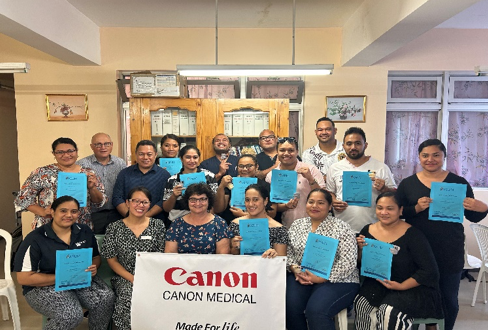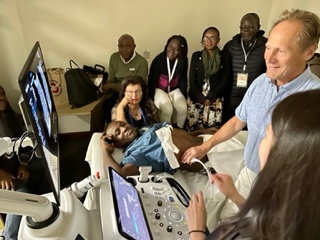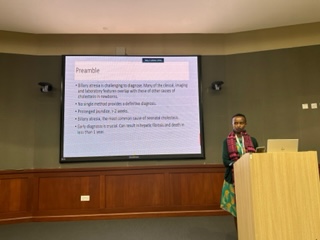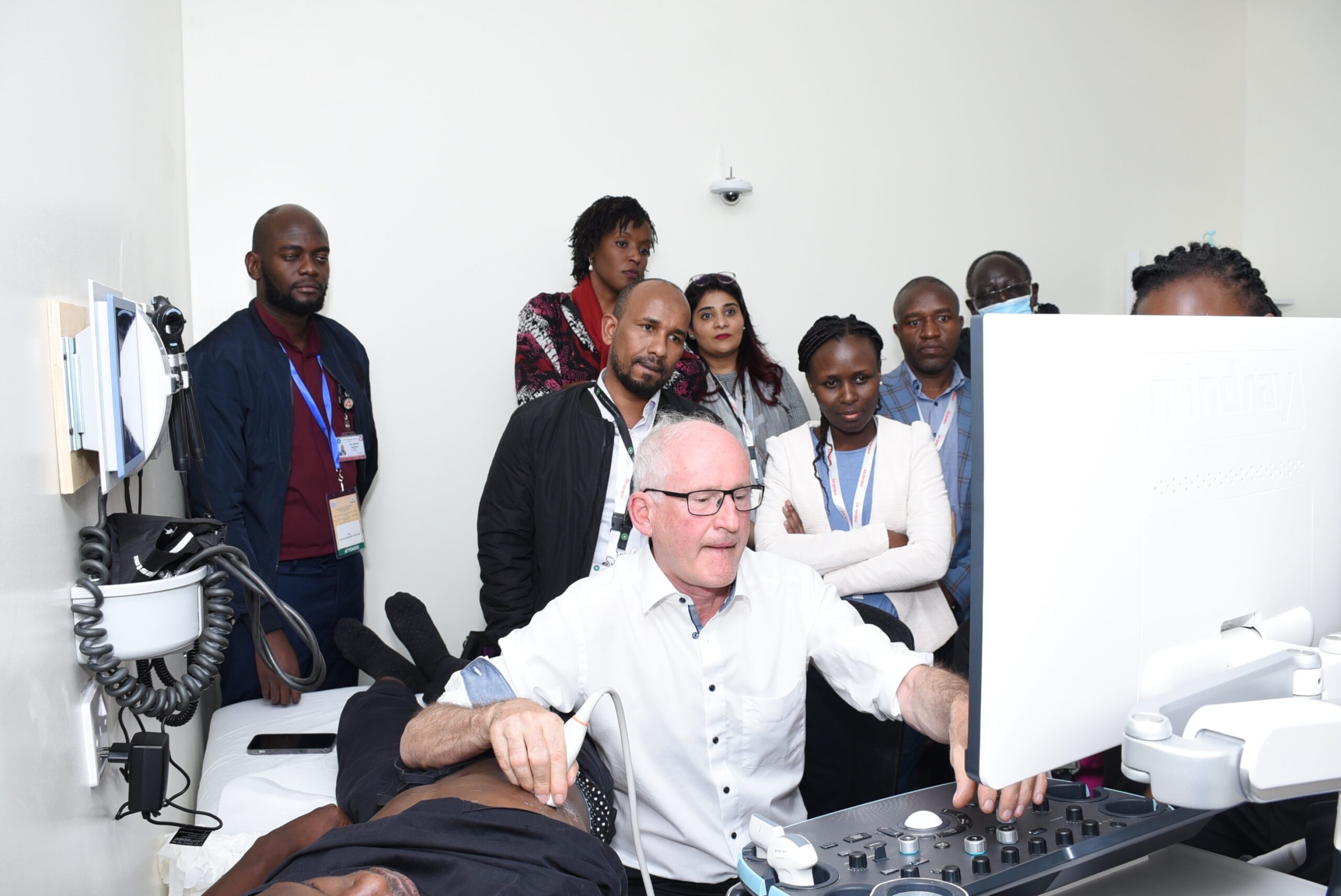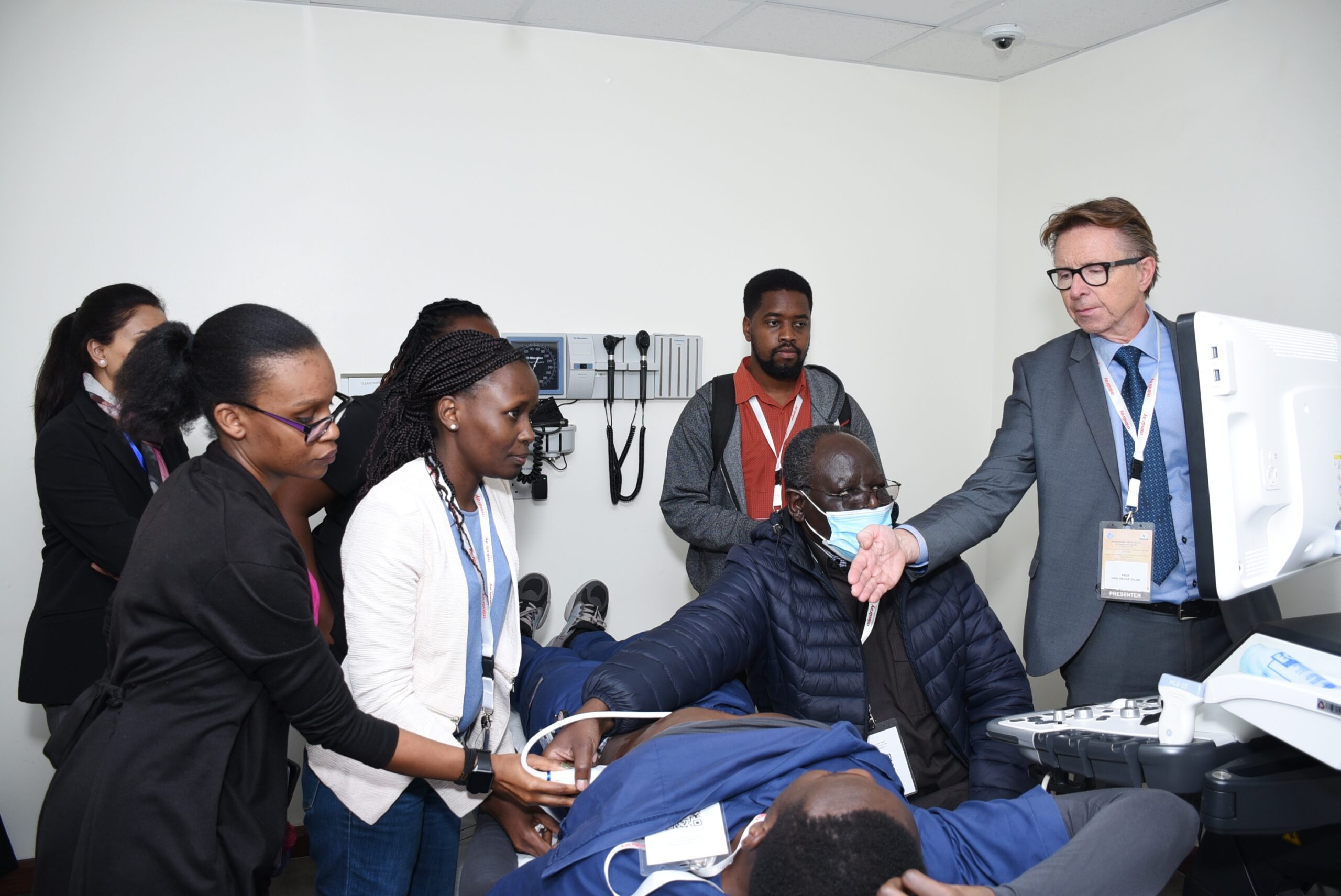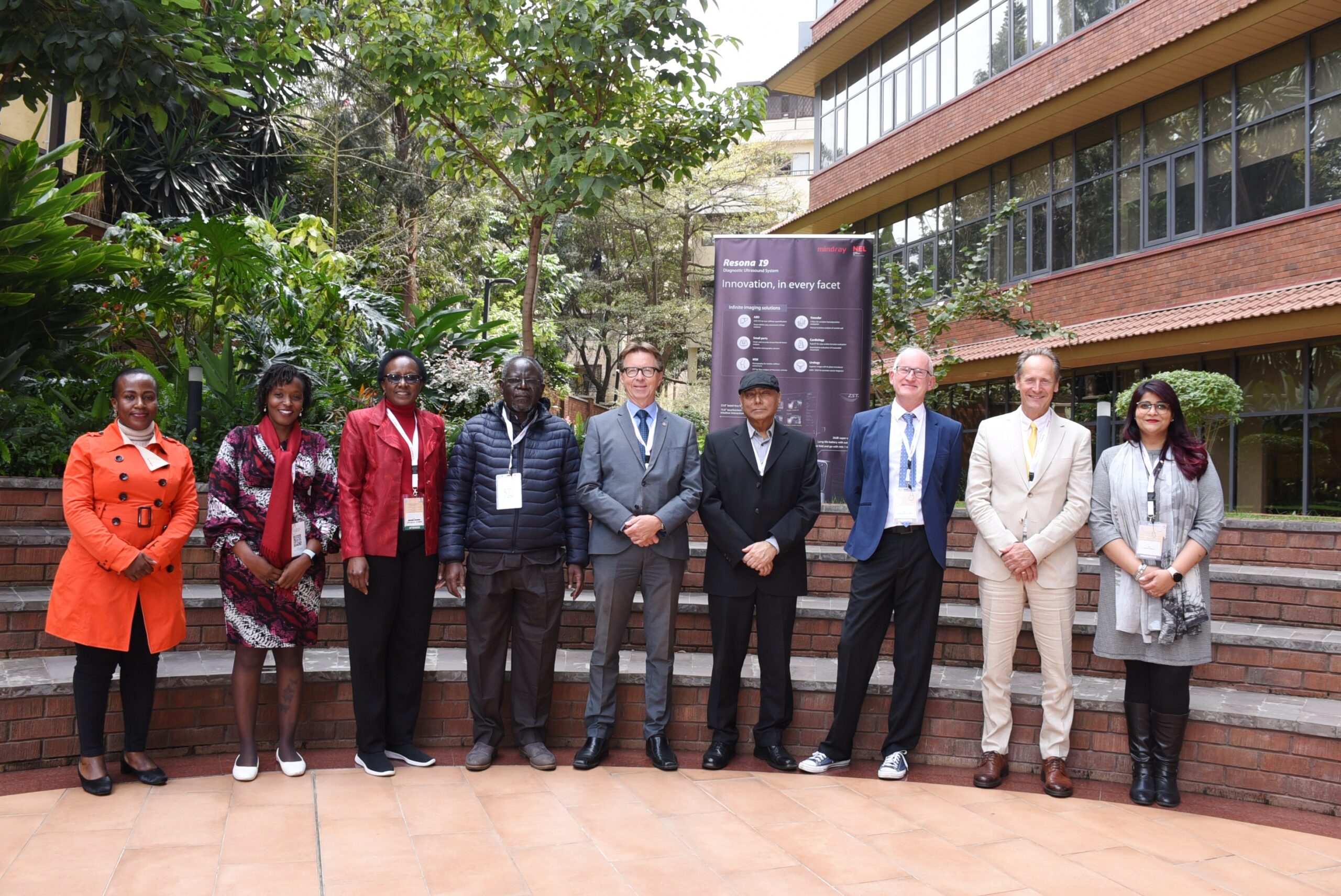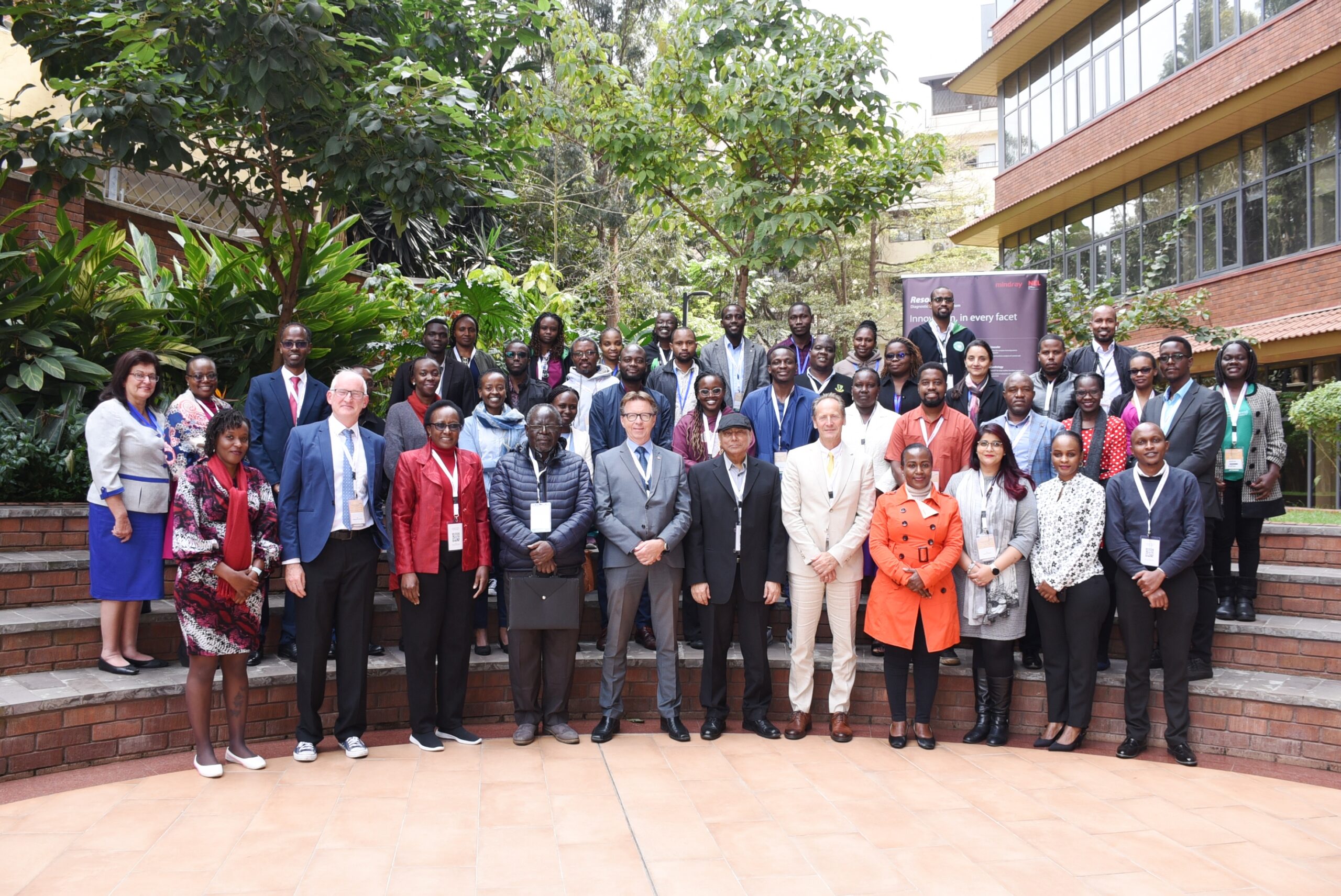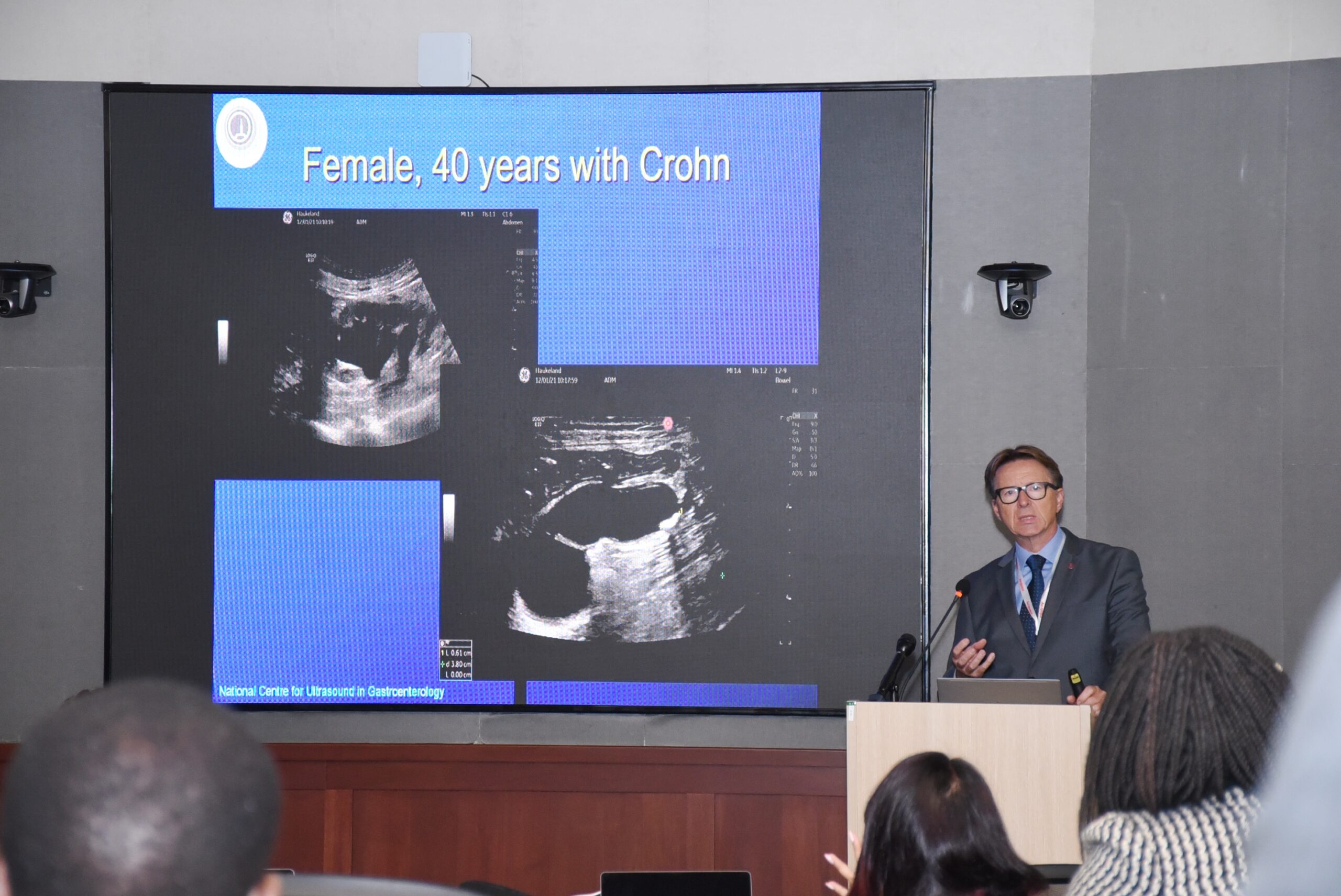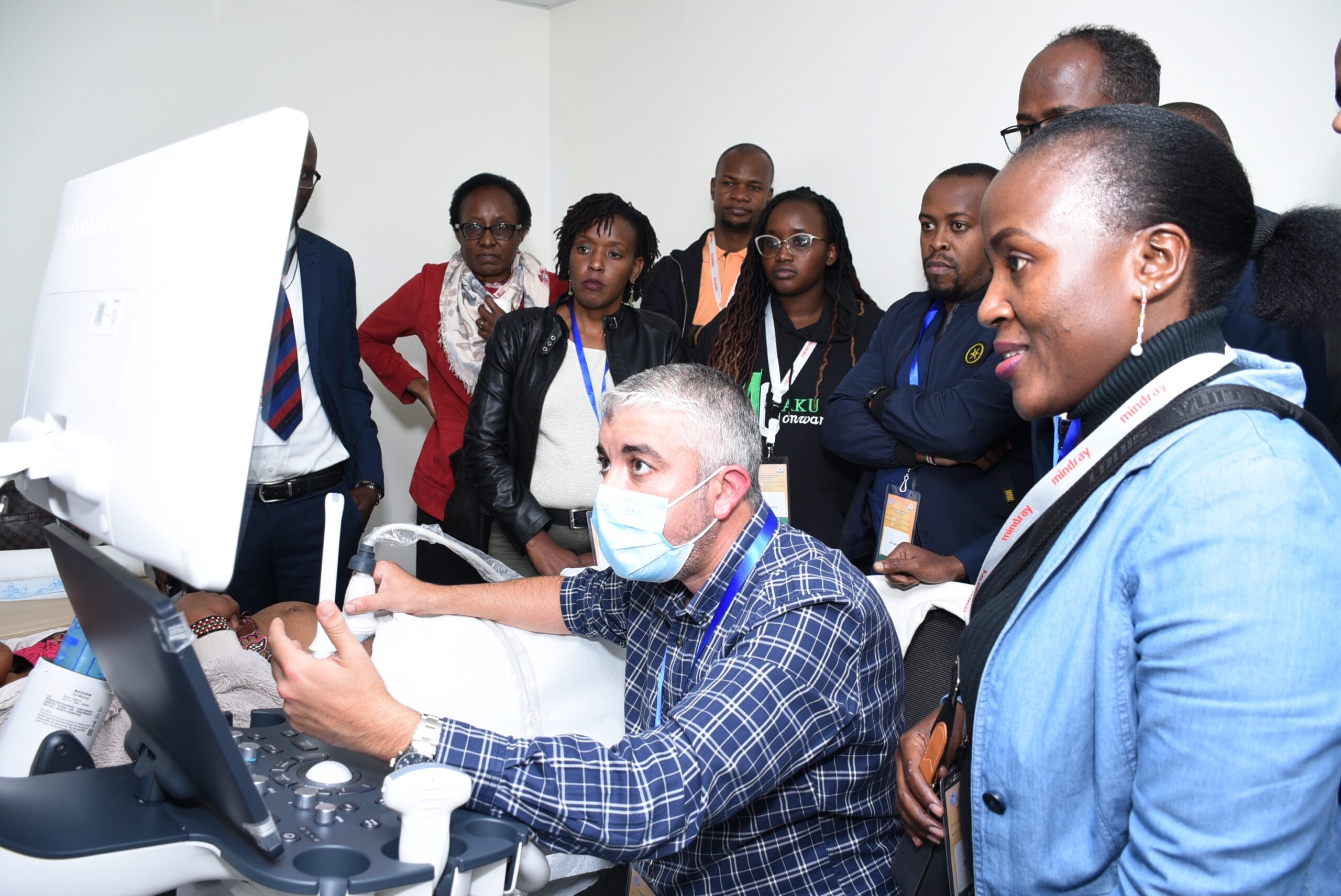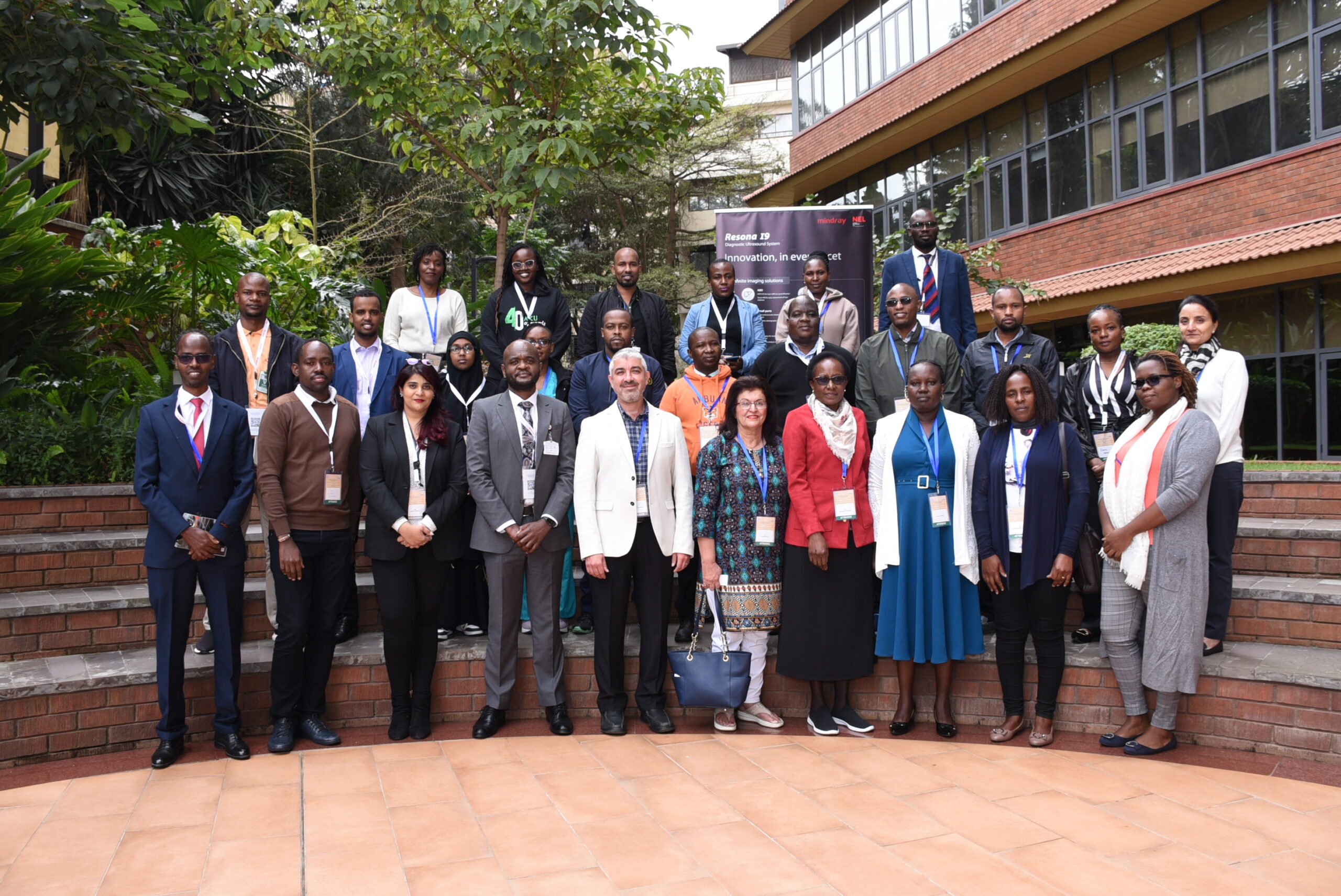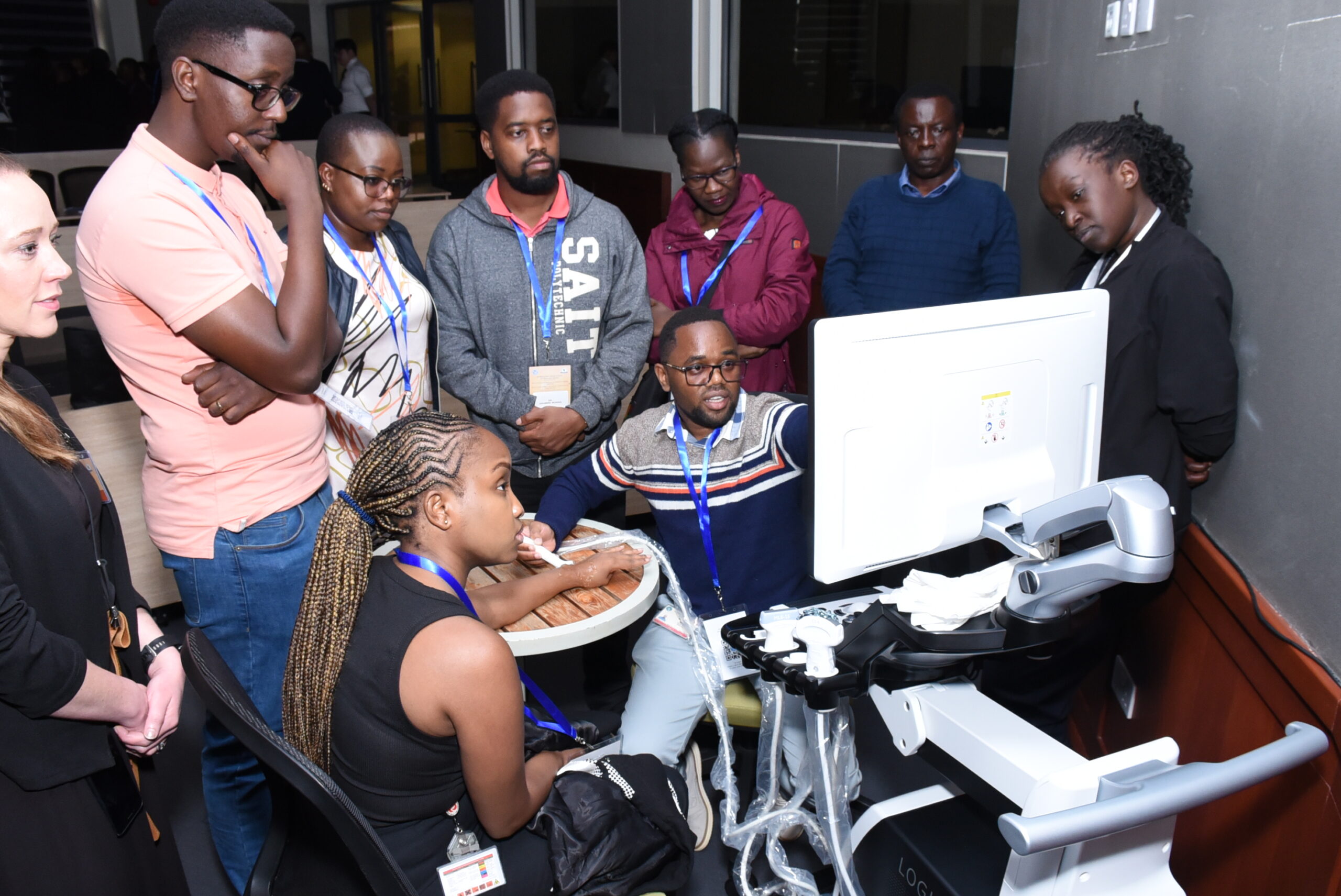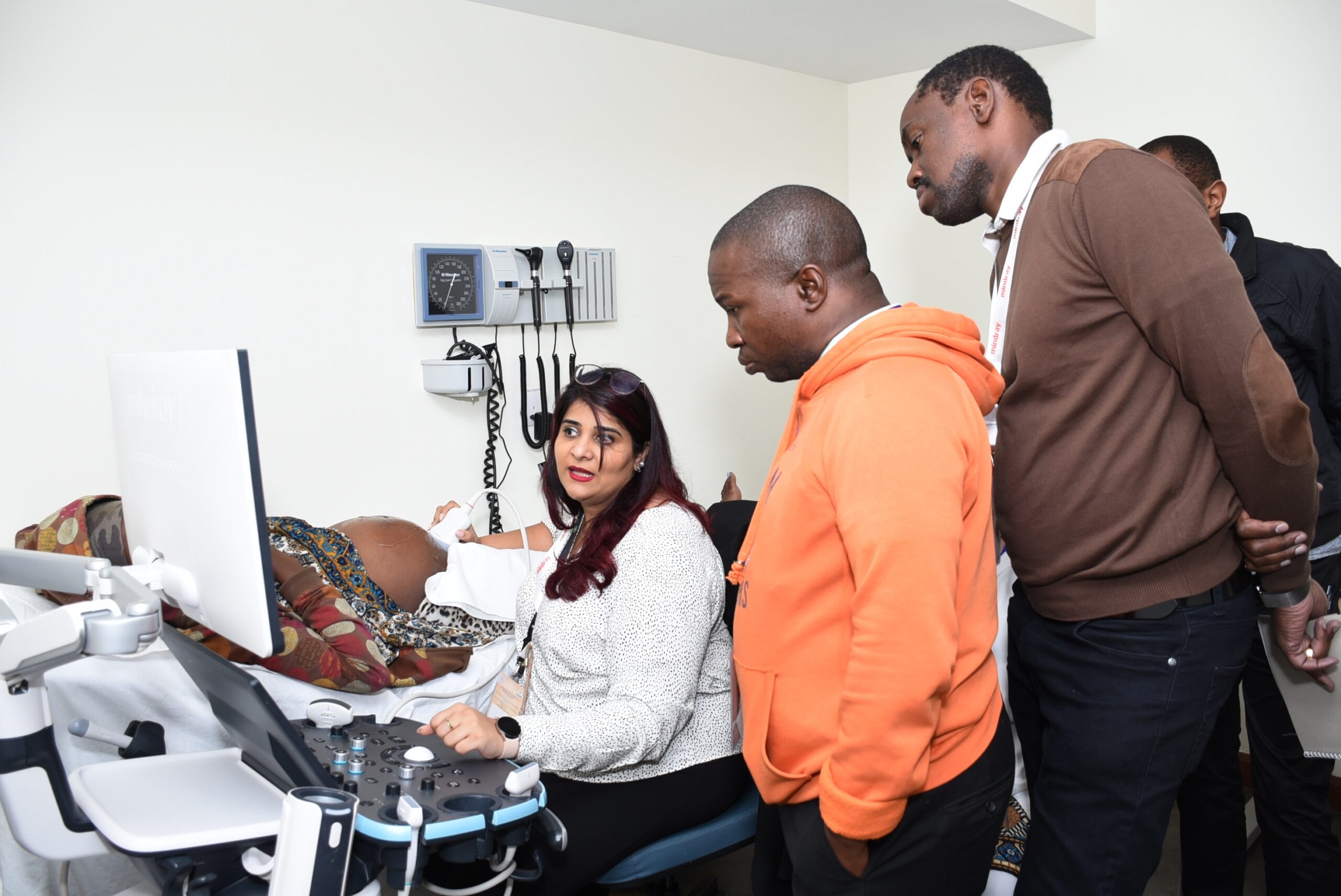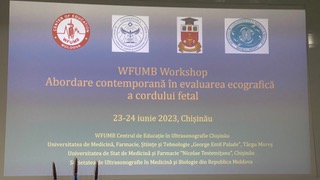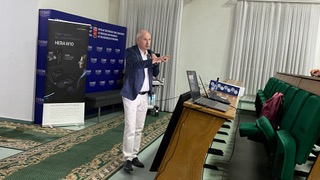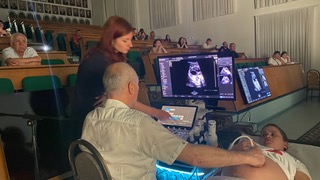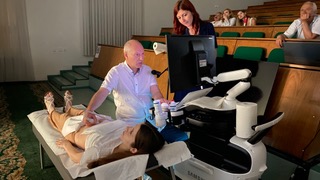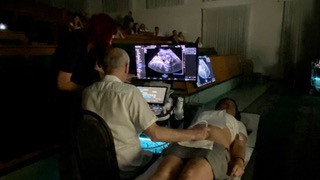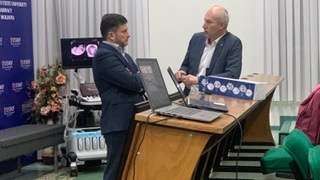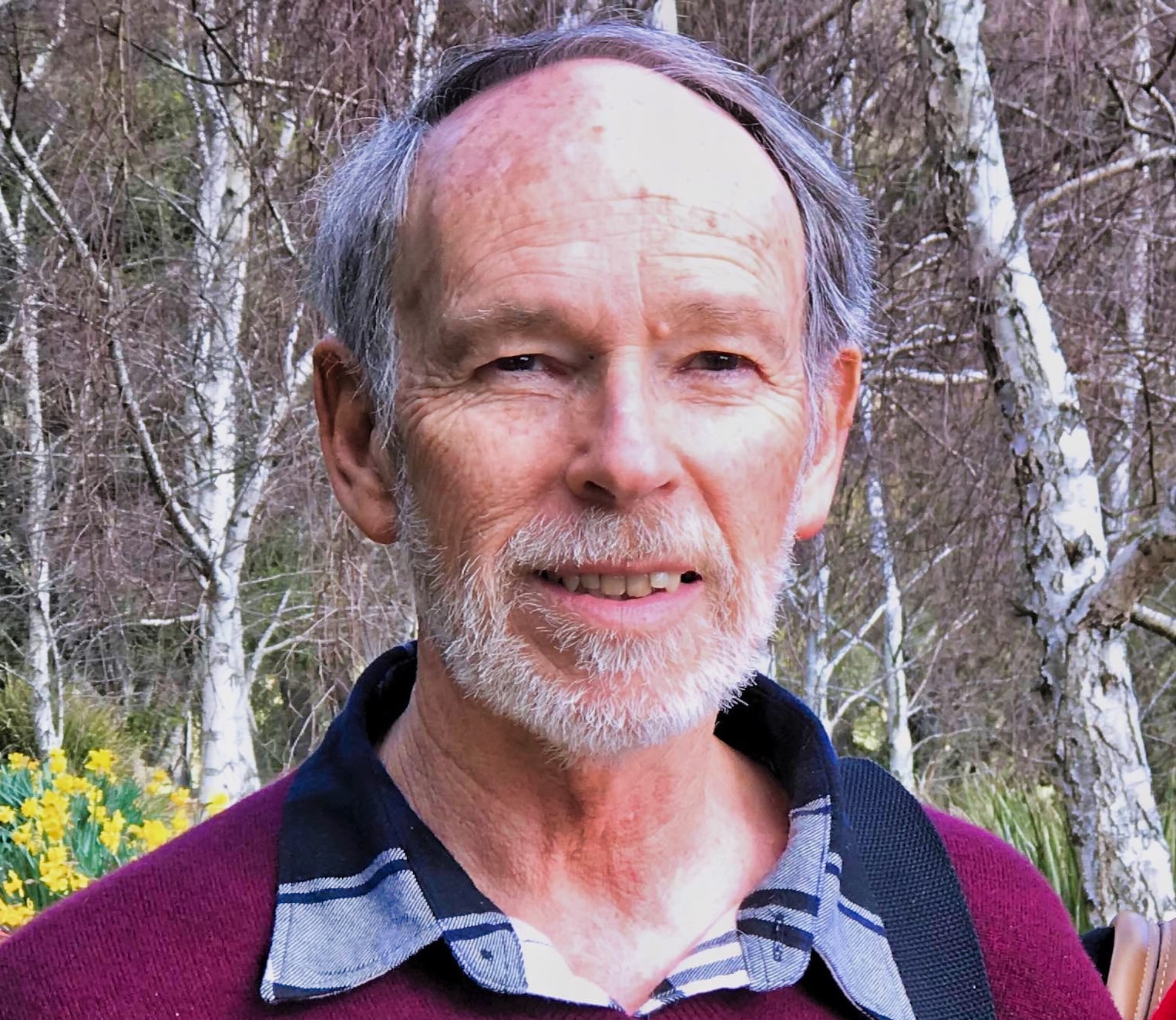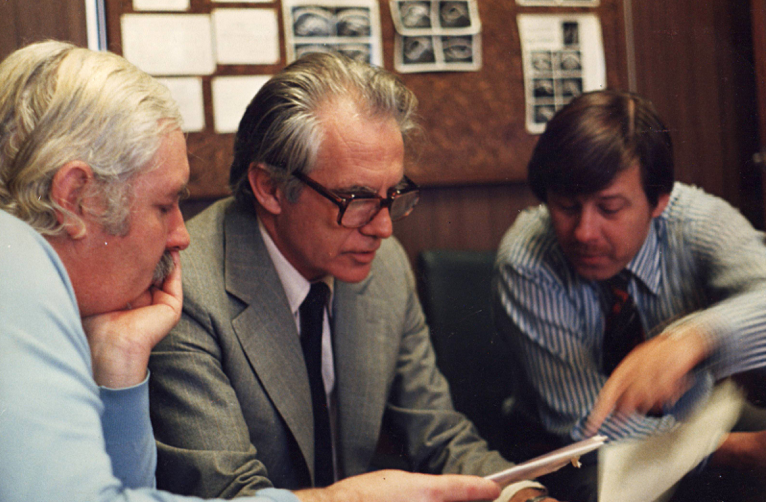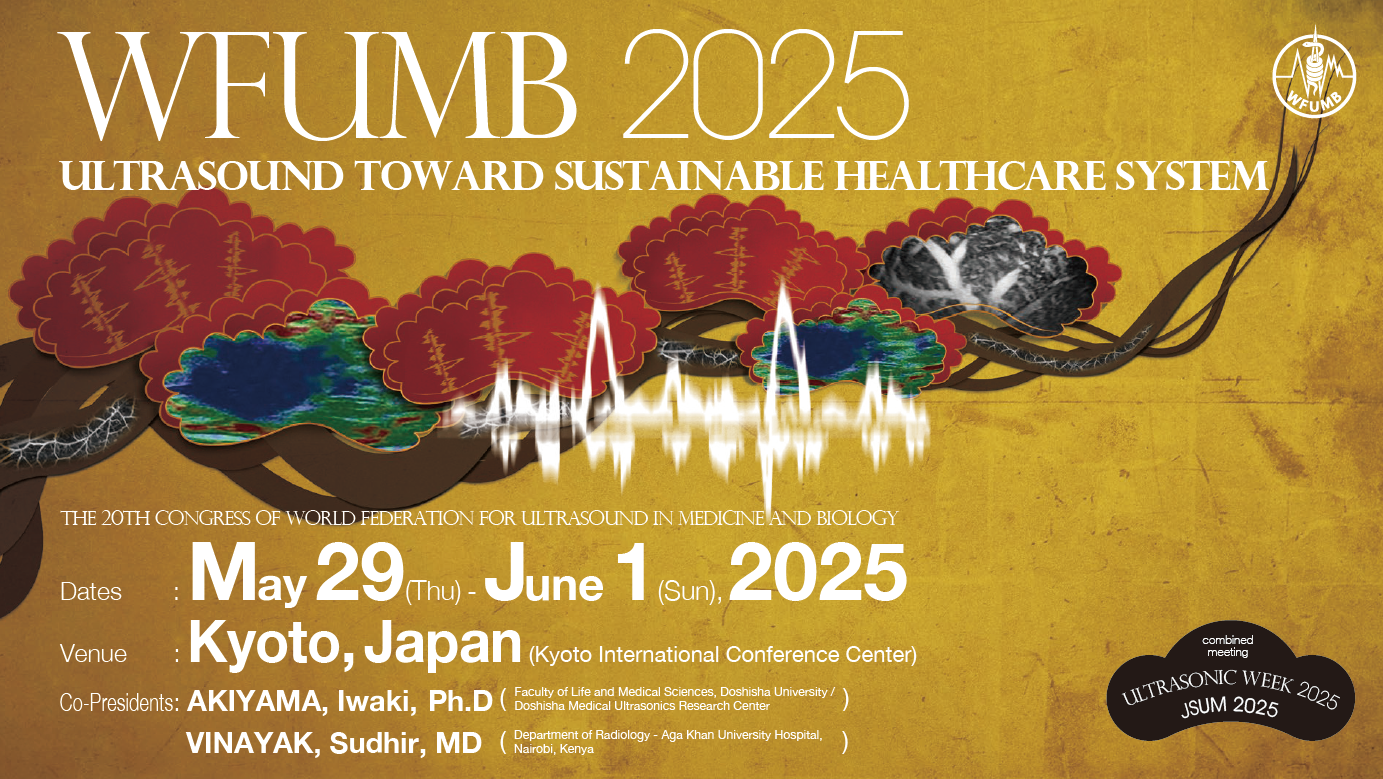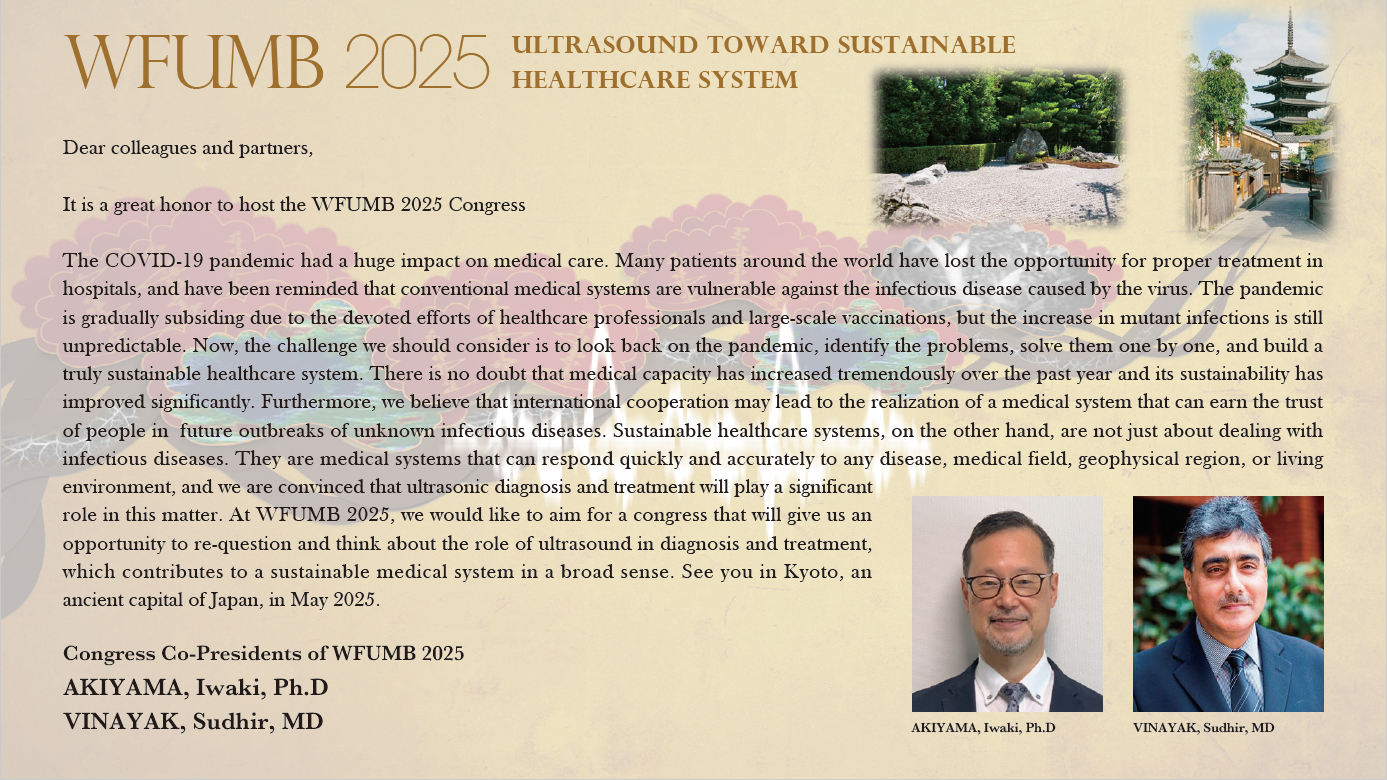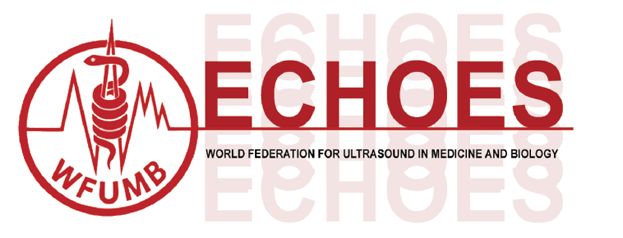
Echoes Issue No. 33 [ September 2023 ]

Welcome to Issue 33 of ECHOES
In this edition of ECHOES we encourage you to be inspired by our luminary interview with the great Australian Engineer Dr Rob Gill, who has been involved in ultrasound for over five decades.
There are reports on courses held at the Moldova and Fiji Centres of Education as well as the Kenyan MASU meeting and Federation news from ASUM.
The WFUMB meeting in Muscat, Oman is in November and there is still time to register for those wanting to attend what promises to be an excellent educational event.
WFUMB ECHOES - Spread the word
Sue Westerway, Publications Committee
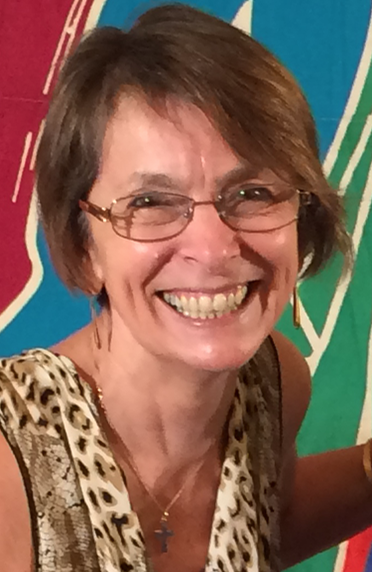
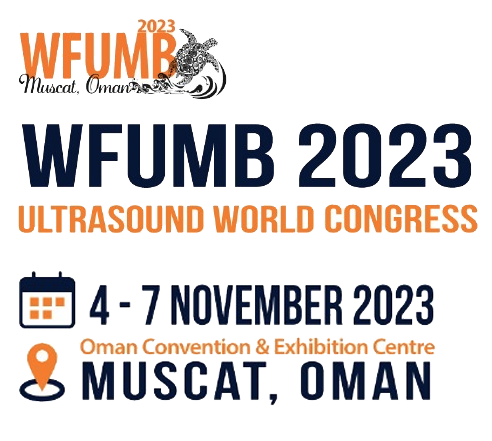
Time is running out to secure your place at this year's WFUMB2023 Congress!
days
hours
minutes
Stay at the forefront of ultrasound advancements, be part of a global community committed to pushing the boundaries of medical imaging with fresh insights, innovative techniques and a broader perspective on the challenges and opportunities in ultrasound.
The Abstract Submission deadline has been extended to the 21st September. Good deals can be negotiated for hotels which include transport to and from the Congress venue. Contact InfoPlus Events for assistance in making your booking.
- Abdominal ultrasound
- Breast ultrasound
- Contrast enhanced ultrasound
- Critical care ultrasound
- Emergency ultrasound
- Hands on workshops
- MSK ultrasound
- Obstetrics and Gynecology Ultrasound
- Pediatric ultrasound
- Small parts ultrasound
- Ultrasound Elastography
- Ultrasound in primary health care
- Vascular ultrasound

ASUM Report
Scholarship: Sonographer Students
On behalf of the estate of the late Dr Delwyn Nicholls, ASUM launched a new scholarship to support student sonographers in rural Australia.
We look forward to announcing the inaugural winner of this scholarship during the ASUM2023 Gala Dinner and Awards.
ASUM Outreach
ASUM Outreach, Canon Medical and the wonderful team at Vaiola Hospital in Tonga have collaborated to design a two-year training program, working side-by-side to provide ultrasound education and training, in Tonga.
Leading up to the first visit to Tonga in May, the ASUM team worked closely with the chief radiographer/sonographer, Lei’aloha Makaafi, to determine the needs of the sonographers in Tonga, at both Vaiola Hospital and the outer islands. Our collaboration determined the goal of our first visit was to focus on obstetric ultrasound. The Australasian team consisting of Jo McCann, Peter Coombs and Brett Ayres, provided online lectures to the team in in Tonga.
This consisted of optimisation, 1st trimester, 3rd trimester and wellbeing, and basic fetal heart. The online training helped establish the various needs of the sonographers and radiographers in Tonga, with a mix of skill and experience across the group.
We are now planning our next visit in November with a focus on vascular. We will also welcome two team members from Tonga to the ASUM2023 conference. You can read the full report on our website https://www.asum.com.au/asum-outreach/
ASUM New Zealand 2023
The ASUM New Zealand 2023 conference was held in Christchurch in July and provided a wonderful opportunity for delegates to meet face-to-face with friends, both old and new, to learn from leading voices across our diverse ultrasound community both in New Zealand and beyond. The program included experts from across many aspects of healthcare, including Te Aka Whai Ora/Māori Health Authority. The formats varied from live workshops, debate, panel discussions and lectures.
Our sincere appreciation goes out to the organising committee, presenters, and our corporate partners for enriching the learning experience of our ultrasound community.
Thanks to Gold partner Philips & Bronze partners biodecon, GE Healthcare, GMS, Sonosite & Tristel
AJUM
The Australasian Journal of Ultrasound in Medicine (AJUM) is a multi-disciplinary journal with an extensive international readership. AJUM has moved to online access only in keeping with our drive for a sustainable future. The growth of AJUM continues with approximately 2000 article downloads in the last calendar year. The AJUM cite score is trending up reaching 1.3 in 2022. AJUM embraces the contemporary practice and practitioners to deliver the latest research and education for all ultrasound professionals.
If you have original research, systematic reviews or a “How to…..” article, please submit your manuscripts to the AJUM online. “How to…..” articles are one of our top downloaded articles and made freely available through our publisher Wiley for our national and international audience.
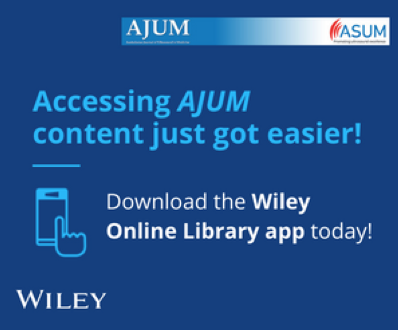
ASUM Membership
ASUM has launched a new pilot membership tier for those in a trainee position. This has been designed to make ultrasound education and training more accessible.
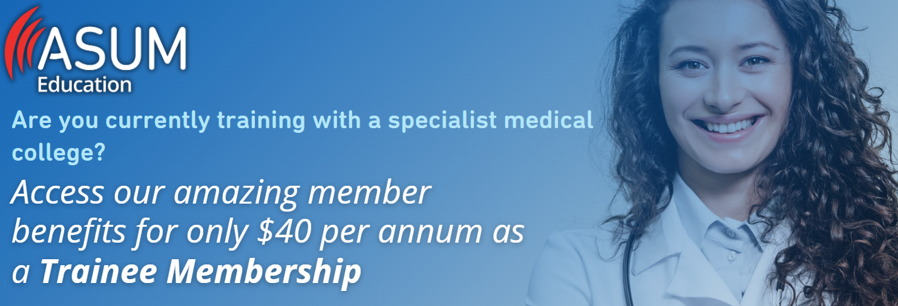

Fiji Centre of Education
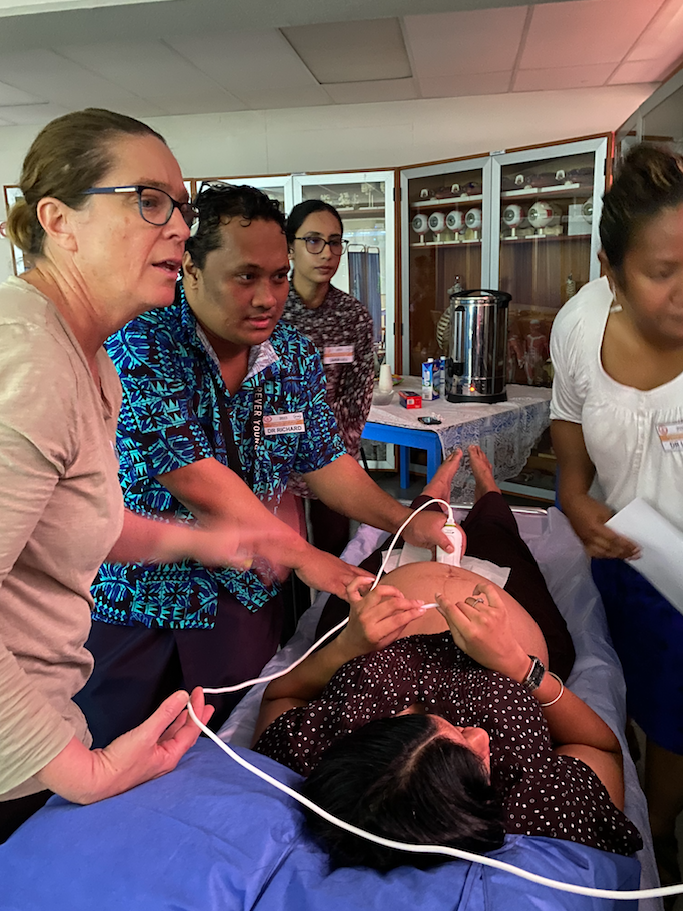
The Fiji CoE utilises the excellent facilities at the Fiji National University campus in Suva and caters for ultrasound users around the Pacific. Good organisation from the FNU Medical Imaging team ensured the smooth running of all events.
By stretching the funding provided by WFUMB, three courses were completed in 2023, giving essential hands on ultrasound education to over 70 participants from every corner of the vast Pacific region. This was only possible with the assistance of our self-funding Australian & New Zealand ASUM outreach volunteers, who gave lectures, interesting case studies and Q&A across a range of topics.
• A 3 day PoCUS course was held in April ‘23 with 3 tutors & 22 attendees from Fiji, Kiribati, Solomon Islands, America Samoa & Samoa.
• An Abdomen course in August ran for 3 days, with 3 tutors, provided lectures and worksheets, with ultrasound pathology framework working through what is needed for examining liver, pancreas, gallbladder, bile duct, aorta, kidneys, spleen & bladder. There were 24 participants from Fiji, Samoa, the Solomon Islands, Tonga, Tuvalu & Vanuatu.
• The final course in September was focused on obstetrics, with 24 obstetricians, GP’s & sonographers taking part. The FNU staff organised 80 antenatal patients over the two days. Five tutors, including fetal medicine specialists, were required to ensure adequate supervised hands on practice.
The Fiji CoE, in partnership with FNU & the newly formed Pacific Islands Society of Ultrasound in Medicine, which is part of AFSUMB, is working towards being self-sufficient by the time the yearly WFUMB funding ceases at the end of 2025. Utilising experienced self-funding volunteers who are willing to return, has become a key point for achieving this aim. There has been a suggestion for volunteers to work in the clinical space in the hospital following a course, which would really embed learning in the clinical environment and begin to give clinicians & sonographers the experience and confidence to apply their new skills.
Here are comments from some of our valued volunteers:
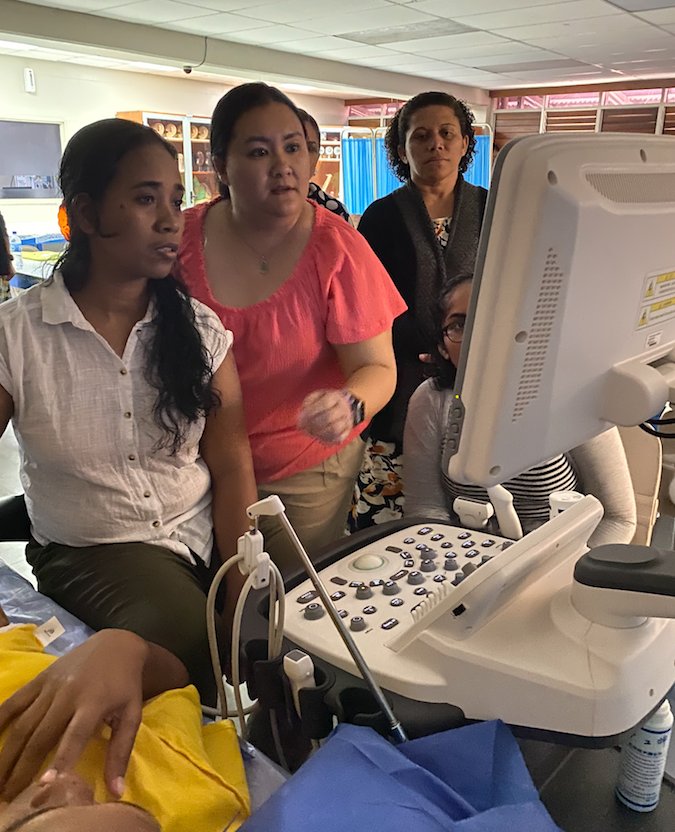
“This was my first outreach through WUFMB and the energy of the faculty and visiting teachers, as well as the participants, was amazing to experience. Ongoing education and support to key clinicians and teachers on the ground will see continued and growing benefits to women and their families with ultrasound contributing to improved pregnancy outcomes. I very much look forward to my next opportunity to be involved with this team” ~ FP - Fetal Medicine Specialist
“My experience as a volunteer with the WFUMB Outreach Program in Fiji was a transformative and eye-opening journey. It was inspiring to witness the dedication and eagerness of the Fijian healthcare providers as they honed their obstetric ultrasound skills which will help strengthen their capacity to provide obstetric ultrasound services independently, thereby ensuring the sustainability of the program beyond our time in Fiji. I am immensely grateful for the opportunity to have been part of this program; it was an experience that left an indelible mark on my professional and personal life, and I look forward to working with WFUMB in the future” ~ JM - Sonographer
“Being able to witness the improvement in scanning of the course participants over a short 2 day window shows the impact these outreach programs are making” ~ TT - Sonographer
Sue Westerway & Raymond Keshwan
Co-Directors WFUMB Fiji CoE
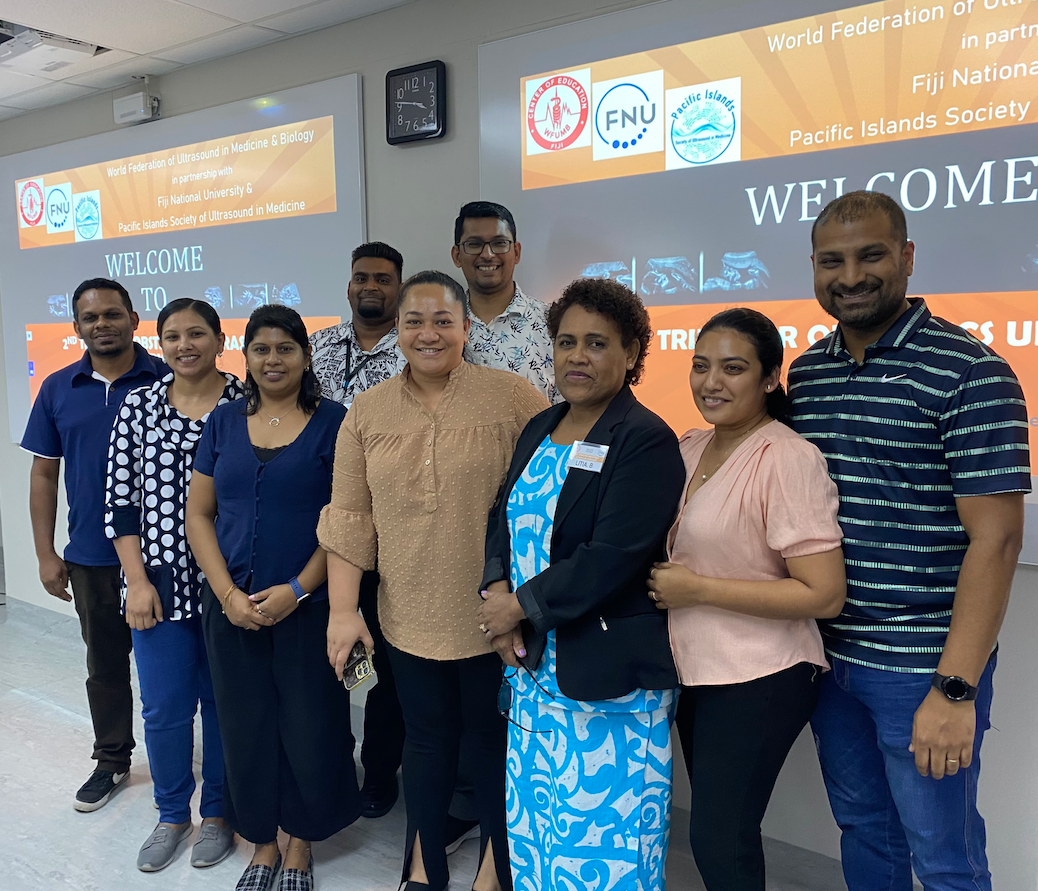


MASU East Africa Regional Ultrasound Conference

The first MASU east Africa Regional ultrasound conference took place in Nairobi from July 26 – 28 2023 with a “PRECONFERENCE HANDS ON WORKSHOP” in MSK and fetal ultrasound.
The African Faculty of Jacqueline Mavuti, Kareem AbdelAziz and Bernadette Muthee gave excellent presentations.
WFUMB speakers (Odd Helge Gilja, Christian Nolsoe and Christoph F Dietrich) were invited to cover topics such as ultrasound of the stomach pancreas, kidneys and urinary tract and ultrasound of alimentary tract diseases, how to teach and learn CEUS, LI-RADS KISS (liver imaging reporting and data system, keep it short and simple, CEUS in pediatric patients, the EFSUMB pediatric registry, lung ultrasound, mission impossible, gallbladder RUQ pain - the POCUS approach, TRUS applications in anal & rectal disease and interventional ultrasound - basic principles & techniques and CEUS and Fusion in interventional US.
Most importantly the “HANDS ON WORKSHOPS” were highlights in the program and enthusiastically attended.
Sudhir Vinayak and his team, with industry support, organised an excellent congress with the attendees treated to excellent African hospitality
Total attendees 105 from Kenya, Ethiopia, Somalia, Uganda, Tanzania and Rwanda
Theme of conference was abdominal imaging
Workshops- musculoskeletal ultrasound, fetal imaging
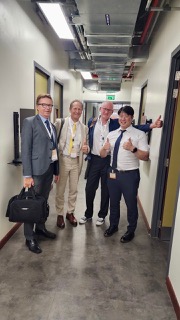
Total attendees 105 from Kenya, Ethiopia, Somalia, Uganda, Tanzania and Rwanda
Theme of conference was abdominal imaging
Workshops- musculoskeletal ultrasound, fetal imaging

WFUMB CoE Chisinau
WFUMB CoE Chisinau Workshop "Current approach of fetal heart ultrasonographic assessment”
23-24 June 2023
Provided for Obstetricians, radiologists and sonographers
71 attendees
Invited lecturer: Professor Claudiu Marginean, University of Medicine, Pharmacy, Sciences and Technology "George Emil Palade", Târgu Mureș and Sergiu Puiu, Director of the WFUMB CoE Chisinau
Topics:
- Extended fetal cardiac ultrasound screening in 2023.
- The wide spectrum of fetal heart anomalies: classification, sensitive points of ultrasound screening of the fetal heart
- Difficulties in the diagnosis of cardiac malformations in the first trimester. Screening performance in Europe.
- Cases of cardiac anomalies in the first trimester.
- Fetal cardiac anomalies: ultrasound diagnosis, prognostic data.
- Live scan demo.

Luminary Interview with Dr Rob Gill
How and when did you become involved in ultrasound?
As an Electrical Engineering undergraduate, I needed to find a work experience placement for the summer break. One of my lecturers whispered in my ear that the Ultrasonics Group in the National Acoustic Laboratories would be much more interesting than the other options I was considering. And it was. I had a wonderful summer working with George Kossoff, Dave Robinson and their colleagues. I was hooked!
Over coffee one day, they asked me if I was planning to get a PhD, and suggested I consider going overseas to do it. I followed their advice and went to Stanford University in California. The Electrical Engineering Department there was exploring ways to use semiconductor technology in medical ultrasound. I joined a project to develop an implanted Doppler blood flowmeter for use in animal research.
After a couple of years, I started to attend medical ultrasound conferences, and ran into George Kossoff and Dave Robinson again. They asked if I intended to return to Australia when I graduated, and so I was able to come home to a job with the Ultrasonics Institute. I’ve often thought how wonderfully lucky I was that the stars aligned in this way.
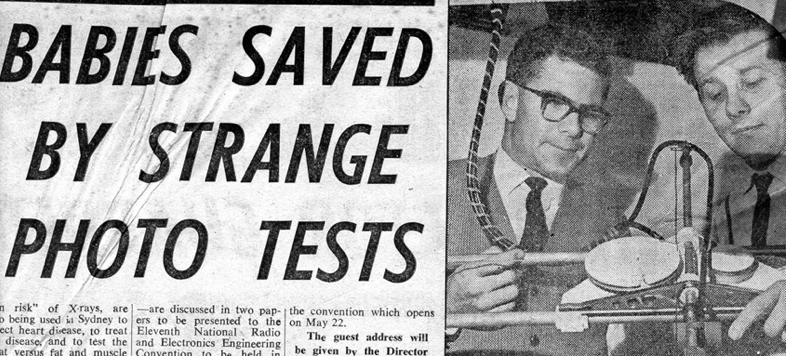
The public didn’t know quite what to make of the early work in the Ultrasonics Group. Dave Robinson (Left), George Kossoff (Right).
Were there any particular people that influenced your work?
George Kossoff, who led the Ultrasonics Institute, and Dave Robinson, his number two, were wonderful role models. My colleagues in the Ultrasonics Institute helped me fill the gaps in my understanding of ultrasound. I learned a lot about medicine, and the very different ways that medical practitioners and engineers make decisions, from Bill Garrett, a fine clinical obstetrician and researcher. The “Friday Sessions” at the Ultrasonics Lab were legendary. Bill Garrett and our other clinical partners would come onto our territory and we would blue sky all sorts of ideas about what might be done with ultrasound and where its current shortcomings lay. I also had the pleasure of working with inspiring and dedicated research sonographers.
What were your career highlights?
Winning a Best Paper award at the top semiconductor conference for a presentation based on my PhD thesis. Winning another Best Paper award, but this time for a clinical paper, for a publication in Ultrasound in Medicine and Biology on the measurement of umbilical vein flow. Later, presenting papers at specialist conferences on fetal physiology and surviving challenges to our methodology and data from some authorities, with significant help from other authorities.
But, most of all, I value the fascinating and generous people I came to know over the years, from the founding fathers of medical ultrasound (people like Ian Donald, Peter Wells, Shigeo Satomura, Jack Reid and John Wild) to my own contemporaries and successive generations of younger researchers.
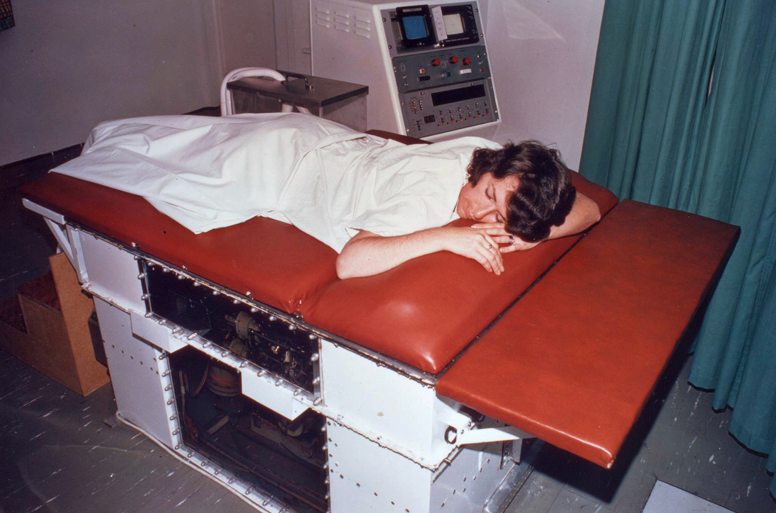
For a long time the Ultrasonics Institute concentrated on water-bath machines. This culminated in the development of the “Octoson” which featured eight large mechanically scanned transducers in a water bath, with the patient lying on top of a membrane. Shown here is the prototype Octoson scanning the Institute’s Kaye Griffiths.
What are your impressions of the ultrasound technology available today?
In the late 90s, some of the leading researchers thought that the equipment of that time had reached the limits of what was physically possible, and further improvements were likely to be modest. How wrong they were! Today’s machines have vastly better image quality and ergonomics, have a wide range of capabilities and an ever-growing range of application areas. And there’s no reason to think the rate of development will slow for the foreseeable future.
Are you still involved with the ultrasound world?
Throughout my research career, I enjoyed occasional opportunities to teach. Following my retirement, I found there was a demand for people able to teach the physics and technology of ultrasound and its clinical implications. I now teach trainee sonographers and medical practitioners in several university and professional courses. I am a member of the Board for the Australasian Society of Ultrasound in Medicine’s Diploma of Diagnostic Ultrasound (DDU). I have written a textbook for my students. I am grateful that I can still contribute to the profession and remain involved through my teaching.
So, I’ve had a marvellous career as a researcher throughout the formative years of medical ultrasound, and still enjoy being a part of that world.
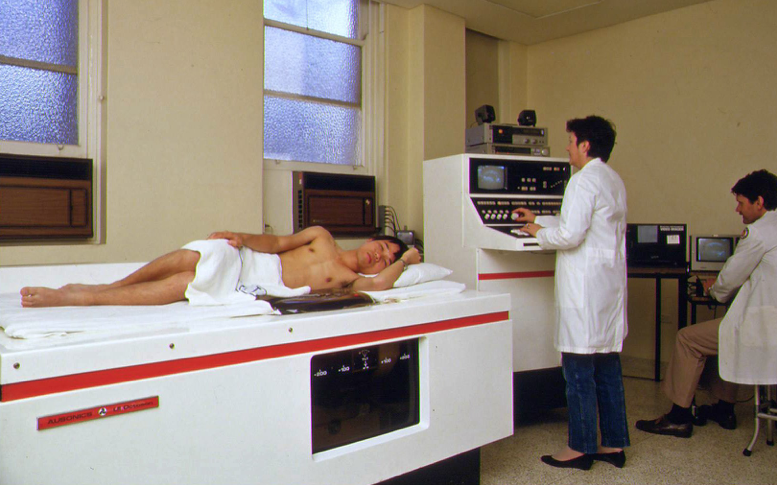
An Australian company, Ausonics, was established to commercialise the Octoson. Shown here is the first commercial unit being operated by research sonographer Kaye Griffiths, with Laurie Wilson looking on. From 1977 to 1982, approximately 200 Octosons were sold worldwide.
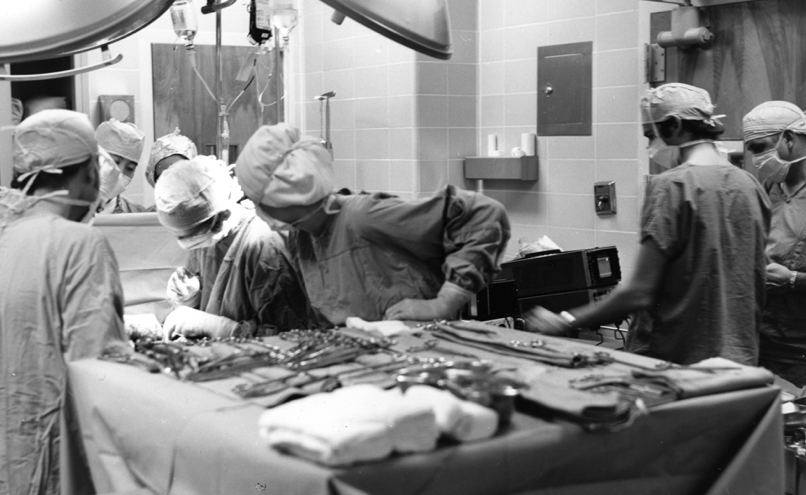
Open heart surgery at the Redwood City VA Hospital. A modified version of the implantable Doppler unit was used to assess patients pre- and post-operatively. Rob Gill is second from the right, monitoring the data on an oscilloscope.
